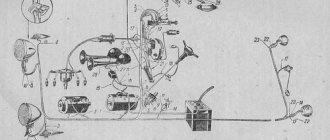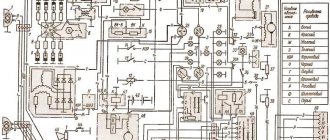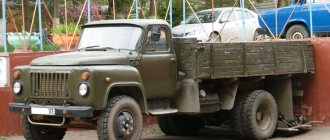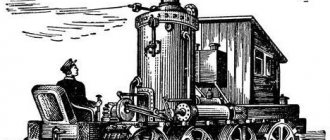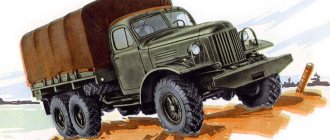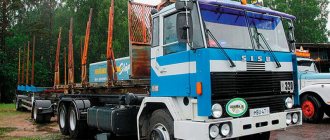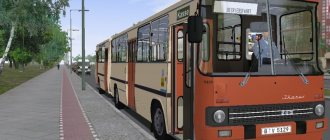Disposable ZIS. The last replica of the plant
Alexander Lazarev, design engineer at AMO ZIL Photo by the author and from the archives of AMO ZIL
ZIL-4329 AP trucks are the most widespread disposable fake in the world history of the automotive industry. They were created as working props for a parade show. And the goal was achieved - out of all 130 cars produced, only a couple of copies survived.
Where can I get sixty ZIS-5s?
The history of the creation of this old-new truck began in 2004. Russian President Vladimir Putin, at the invitation of Ukrainian President Leonid Kuchma, visited Kyiv on October 28, 2004 as a guest of the celebration dedicated to the 60th anniversary of the liberation of the Ukrainian SSR from the Nazi invaders.
At the military parade, all types of Ukrainian troops marched along Khreshchatyk. The parade was opened by the legendary T-34 tank, followed by Willys, two restored ZIS-5V trucks and one GAZ-AA lorry with soldiers in the back, dressed in military uniforms from 1944.
Then several dozen open UAZ-3151s drove by, drove the veterans to the honorary podium, dropped them off and left in the same formation. The action looked theatrically fresh and original.
In all likelihood, it was then that the idea arose the following year, during the celebration of the 60th anniversary of the Victory, to see something similar at the Moscow May parade, and at the same time to amaze the invited heads of liberated states and countries of the anti-Hitler coalition with its scale.
What does it cost us to build a ZIS!
Work began immediately. Already in November, an order was rushed to the ZIL plant to prepare a prototype copy of the ZIS-5 car on the chassis of a serially produced truck of the ZIL-4331 family. Let me make a reservation right away: initially, of course, they wanted to send original wartime trucks in a convoy; it would have been beautiful and correct. But a lot of them were required, several dozen, and they were all not in the best technical condition. In addition, a huge amount of work was required, associated with the manufacture of a whole series of new parts for this entire column, and then it was necessary to train the drivers to drive them flawlessly.
In 4–5 months such work could neither be completed nor organized. The matter seemed not so much troublesome as expensive. But a cheaper and more elegant option was needed. Therefore, it was decided to take serial trucks and replace the cabin and tail, and install modern seats in the rear for comfortable transportation of veterans.
The very first copy began to be collected at the end of November 2004. For this purpose, they took an experimental truck, presented a year earlier at MIMS-2003, and later at the Golden Autumn 2003 exhibition. They removed the cabin from it and began to model it. The first photo of the parade truck is dated November 23, 2004. The chassis was planned to be taken from the short-wheelbase medium-duty truck ZIL-432930 with an MMZ-245 diesel engine. The cabin is a metal frame measuring 20x40 mm with 10 mm plywood hung on it.
ZIL-169: story with the hood
While sorting through the archives, I accidentally came across a photo of a ZIL-169 bonnet truck, dated 1974. Seems like a reason for an anniversary, I thought. But it was not there. The topic turned out to be so confusing that in the end it turned out not to be an “anniversary”, but an excursion into the history of the creation of the model - the predecessor of the current ZIL-4331
Sergey Zhukov
Before starting the story about the ZIL-169, it is necessary to plunge a little into history.
The beginning of the 60s of the last century, the Russian automobile industry is simply bursting with ideas and proposed models. ZiL also does not stand aside from these processes. The promising ZIL-130 has not yet been put into production, but vehicles with a reserve for the future are already ready. In particular, in 1963, the three-axle ZIL-133 (6x4) model appeared, designed to increase the productivity of rolling stock in connection with the growth of transportation and economic recovery.
The matter does not stop there. Recognizing the promise of the design of a truck with a cab over the engine, a similar vehicle is also being developed here, which in the future will have to replace the ZIL-130.
On December 25, 1964, the prototype of the “Zilov” cabover ZIL-E169A, made on the “one hundred and thirtieth” chassis, leaves the factory gates. In appearance, the car resembled American models. And this is not surprising. In general, the ZIL design school gravitated towards the USA. By the way, this was not the first and not the last case. Next year the car is sent for testing. The design as a whole turned out to be successful and, after eliminating the defects, it was recommended for production.
However, the design of the ZIL-E169A is outdated by the time decisions are made. Time moved inexorably forward, as did the demands put forward by the economy. In the depths of the design bureau, designers are creating a new look for the cabover. So in 1967, a working sketch of a truck developed by Zilov designer Lev Samokhin appeared.
Having placed the ZIL-130 on the conveyor, the load capacity of which at different times ranged from 4 to 6 tons, the designers went to the limit of the maximum permissible load on the drive axle, which was determined based on the road restrictions in force at that time. At the same time, it became clear that a further increase in carrying capacity is possible only by increasing the number of axles - the permissible load on a trolley from two drive axles was limited at that time to 11 tons.
Therefore, having developed the ZIL-133 (6x4) family of vehicles, the launch of which was delayed for various reasons, ZIL in 1967 began work on a new promising family of ZIL-170 (6x4) vehicles, similar in class to the ZIL-133.
And then, as luck would have it, the resolution of the Central Committee of the CPSU and the Council of Ministers of the USSR No. 1084 of November 16, 1967 arrived on the creation of a new family of tractor-trailers. For the mass production of cars, it was planned to build a complex of seven production facilities with a total area of about 3 million m2, which were supposed to conduct almost the full production cycle for the manufacture of heavy-duty vehicles. Once at full capacity, it was expected to produce 150,000 cars and 250,000 diesel engines per year.
Whether on their own initiative, or on orders from above, it is not known for certain, the promising family of ZIL-170 trucks overnight became the prototype of KAMAZ. ZIL concentrated all its efforts in this direction.
By the way, already in 1968, Moscow automakers completed the development of design documentation and built the first prototype of the ZIL-170V75 truck tractor with a 210-horsepower promising diesel engine YaMZ-6E641. According to the technical specifications, the family of promising trucks included only three-axle models.
In addition, in the early 1970s, the USSR, within the framework of CMEA, had to develop and put into production at least two completely new families of trucks with different carrying capacities. At the same time, our country set a course for the general dieselization of freight and bus rolling stock.
As already noted, by the time the government decree was issued, ZiL was working hard on its promising models, creating a foundation for the future. We already know about the three-axle vehicle with a cab over the engine and a 6×4 wheel arrangement of the ZIL-170 model. But there was another initiative development - a two-axle ZIL-169 truck of the same layout. It was not only designed, but also built in December 1969 and underwent factory testing, receiving the designation ZIL-3E169A. According to the Zilov team, it was supposed to become the successor to the ZIL-130. In addition, the cabin of the ZIL-3E169A was identical to the three-axle ZIL-170.
After transferring to Naberezhnye Chelny all the documentation for the ZIL-170, which by that time had become KAMAZ-5320, the ZIL design bureau returned to the 169th model. However, by the mid-1970s, the auto industry, as well as throughout the country, entered a period of stagnation. This is precisely what can explain the fact that in the course of further work on the ZIL-169, technologists and production workers took over. Despite the huge funds allocated to the plant, it was decided to use as much as possible in the design of the car units and technologies already mastered in existing production. Thus, ZiL returned to the hood layout. And under the old index “169” a completely different machine began to be designed.
Imperceptibly we approached the culprit of our story.
Cabin interior of the experimental ZIL-4E169G (1974)
In 1973, the same Lev Samokhin developed models of hooded ZIL-169 trucks, and already in 1974 the first prototype of the ZIL-169G truck appeared, very reminiscent of American trucks of that time: with a large hood and a small cabin. A characteristic feature of the new ZIL-169 is its integrated tail. To test it, in the same year, versions of the ZIL-130 trucks with integrated upper and lower tails were created.
In April 1976, at an exhibition organized by the plant in honor of the visit of the country's top leadership headed by Leonid Brezhnev, a display of experimental machines took place. These were already samples from 1975. Among them is a long-wheelbase ZIL-7E169G truck with a GKB-817 trailer. The cars were the second version with angular cabins of increased volume. All of them were equipped with a promising diesel power unit ZiL-E645 (V8; 8.74 l; 180 hp), the production of which was to be launched in the village of Yartsevo in 1981.
ZIL-4E169G was tested as a single truck...
...and with the GKB-8350 trailer as part of a road train
By 1979, the appearance of the truck had undergone significant changes: the hood, tail, and most importantly, the cabin. She has practically acquired her final features. By the way, elements of the ZIL-170 cabin were used when designing the cab of the bonneted ZIL-169. In addition, the ZIL-130 produced at that time received an improved braking system, developed during the creation of the ZIL-170.
In 1984, at the exhibition dedicated to the 60th anniversary of the domestic automobile industry, the ZIL-4331 appears, this is still the same but slightly modified ZIL-9E169G of the 1978 model, but renamed in accordance with the introduced industry standard for the designation of automotive rolling stock.
The well-known serial ZIL-130 (1964)
By the way, in the same 1984, at the training ground in Dmitrov, one could see the final version of the ZIL-4331 with lighting equipment located in the bumper. In addition, the tail was shortened, the radiator lining was made of ABC plastic across the entire width of the tail, and it became voluminous. At the same time, the front part of the car has become significantly thinner. This version, with minor modifications, left the factory gates in 1985 and subsequently entered the assembly line.
One of the first prototypes of the ZIL-133G (1963)
In general, the development of the ZIL-169/4331 truck took just over 10 years. But it did not bring success to ZiL. Here is one of the comments addressed to the truck: “For the sake of an imaginary economic effect, the load capacity of the road train was increased, which entailed the use of a more powerful power unit, which increased the curb weight of the truck while maintaining the same load capacity, and required huge investments in the creation of new production facilities in Moscow, Yartsevo and Smolensk . The focus on the primary operation of a medium-tonnage vehicle as part of a road train turned out to be erroneous; its scope of application in a market economy has narrowed to use in relatively small quantities as single chassis for the installation of specialized superstructures. Moreover, due to low annual mileage, consumers preferred to purchase cars with an outdated gasoline engine or a Minsk diesel engine of lower power, which is why the production of more powerful diesel engines had to be curtailed.”
Does this not explain the fact that an almost unchanged truck today is offered only with gasoline engines and the same Minsk engine of “tractor” origin?
The first cabover ZIL-E169A (1964)
ZIL-170 with trailer GKB-8350 (1969) - prototype of KAMAZ
Initiative ZIL-3E169A with trailer GKB-8350 (1969)
ZIL-7E169G - one of the stages in the development of the 169th model (1976)
ZIL-9E169G and also the first ZIL-4331 (1978)
And this is how the serial ZIL-433100 appeared to us in 1985
With this material, the author does not claim chronological sequence or accuracy of any facts. It’s just that the photograph awakened “Vereshchagin feelings” - it’s a shame for the state!
The editors recommend:
Why do piston rings stick and how to prevent it?
A traffic police officer searched my car: did he have the right to do so?
Russians may be left without foreign cars: Western automakers have stopped supplying cars to our country
A ship that was transporting cars to Russia was detained in France
Half of the car factories in Russia have closed
Discussion Cancel
Depressive original
The difficulty was that the 3-ton ZIS-5V was going to be copied, and in 60 years the plant had stepped so far forward in terms of carrying capacity that it was necessary to make a 3-ton vehicle from a 6-ton one. Hence, the difference in size inevitably began to emerge. The next day after the production of a running prototype of the ZIL-4329 AP (ceremonial car), on November 24, the first in-plant show was scheduled for director K.V. Laptev.
What he saw put the director into a state of heavy thoughtfulness, and the factory workers into shock. Especially considering that behind the wall there was an original ZIS-5, which had nothing in common with the displayed sample. An incredibly scary bonnet, a frightening gap of the radiator lining measuring one meter by one meter. This design had nothing in common with the elegant “three-tone”. People who saw this terrible hippopotamus for the first time were literally speechless.
The model monster, terrible as war, turned out to be not even a replica, but a primitive collective farm homemade product. Nobody dared to show the customer the car in this form, so they immediately set about remodeling it. The director didn't even swear. But it became clear to the designers and craftsmen which direction to move and which edges should be remeasured.
There were no serious questions about the cabin, except that the door was narrowed and an error was made in the proportions. But they took the plumage seriously. We selected a narrower radiator, slightly changed the location of the hoses and other lines near the engine, all this made it possible to make the radiator trim and the hood closer to the original.
By the evening of Monday, January 24, the car had already been assembled and inspected, and on Tuesday the 25th, the still unpainted truck was tested on an “autoshaking” vibration stand to determine the reliability of the frame with plywood panels and its suitability for movement on the paving stones of Red Square.
How a red raccoon became friends with a Centaur
After the fiasco with the Yunost cabin, there were only two options left: to return to the ZIL-4331 cabin or to use the Chinese Sinotruck cabin of the CNHTC concern, used on the ZIL-4329MO and ZIL-4362MO trucks of the Centaur series (see “MMAS-2006 new items from A to Z"). The Chinese one was more modern and aesthetic, especially since it was developed in Germany and installed on reliable and popular MAN L2000 series trucks, which the concern produced under supervision in Poland and without supervision in China for products of the CNHTC corporation. Polish cabins were made more carefully. The Chinese paid less attention to the detailing and elaboration of individual parts, but announced an incredibly low price for the entire line of such cabins, as long as the conveyor did not stand idle. This became decisive in choosing a supplier. The ZIL plant purchased a batch of such cabins for its promising Centaur family (see MIMS-2007 + INTERAUTO-2007). General Director K.V. Laptev had high hopes for the family of medium-duty vehicles with a cabin over the engine. In this he saw new life for the ZIL-4331 family. In total, at least 70 cabins were purchased. The plant even intended to produce them on its own in 2008, for which separate stamped panels and a welding jig were purchased (see “The Ninth Comtrans”) for the HOWO-ZIL line.
A similar project of the standard ZIL-4331 in a cabover version was proposed for implementation back in 1992–1993 by Tkachenko’s group, but due to design inconsistencies this idea had to be abandoned (read earlier). In 2006, history repeated itself with a new cabin. Having appeared in 2006, the truck was certified only in 2010... and became serial on paper.
All this time was spent on the complete adaptation of the Chinese version of the MAN L2000 cabin and the correct interaction of all systems. The result promised the market a good truck. But either it was raw, or the price was high, but it was sold out poorly, preferring the time-tested ZIL-4331.
In view of the above, there were no problems with the removal of one cabin for the construction of prototypes. The lower apron (under the headlights) and the first step were removed from the exterior. But the main problem was the width of the cabin, which needed to be narrowed by 150 mm to acceptable dimensions of 2.2 m. It could have been left as is, but they decided to cut it. As a result, they cut out 15 cm from the central part, and then carefully welded everything. The windshield was ordered from a specialized company. Externally, the cut revealed almost nothing, but inside everything was roughly cut in two: both the instrument panel and all the cabin upholstery. It is unclear how the plant was going to mass-produce cars with such cabins.
The truck was repainted again, this time red, and it was in this color that it was shown at the ComTrans-2010 exhibition. This “red raccoon” aroused interest among buyers and bewilderment among specialists familiar with the realities of the plant. The car really looked new. The main thing that the creators wanted to achieve was to move away from “Bull”. Highlight the project as a junior family with a cabover cab.
The new cabover ZIL-230100 in 2010 became the last attempt by AMO ZIL to enter the one and a half class (see “GP” No. 6, 2010). The main competitors were no longer the Gorky long-wheelbase GAZelle GAZ-330202, but the Chinese JAC, FAW, Foton and Yuejin, whose fleet had already exceeded 5 thousand. By installing the cabin above the engine, the designers gained in size, allowing more length to be allocated under the platform. However, the cabin itself remained 2-seater. Accommodation for a third person was possible only when installing a motor with an inclined block or a boxer power unit. There were no such engines in the Russian Federation, and the foreign analogue led to a significant increase in price.
Another drawback is the underloading of the rear axle: because of this, the car behaved disgustingly without a load on a bad road. This problem had to be solved by moving the engine within the wheelbase, or installing a rear axle with a self-locking differential on the entire line of cars. The gearbox had a long lever extending to the rear of the cabin with a physically non-ergonomic gear shift algorithm with a crook of the right hand behind the lumbar region - anyone who has seen how gears are switched on a GAZ-66 will understand. In the 21st century, this aspect should be solved by using a joystick or a rod system.
Well, the main thing is the price. How much should all this cost after solving numerous problems? To compete with GAZelle and the Chinese, a Moscow truck should cost no more than 20–25% more, while being more reliable. Only in this case did he have a chance to gain a foothold in the market.
The irony of fate in the factory backyard: the “blue raccoon” found refuge in the back of the “red raccoon” ZIL-230100
Add a board!
The first show to the main customer (RF Ministry of Defense) took place on Thursday, February 3, 2005 in the experimental workshop of the ZIL plant. A major general and a colonel from the customer's side came to the show. The director and all production managers involved in the project were present from the plant. The show was successful, the vehicles satisfied the military, and they signed the documents, approving this type as the final one. The only change the military asked for was the elimination of the high side rail on the rear sides. It stood out too much from the side, and it was decided to extend the side with one board on the side. Everyone breathed a sigh of relief. The wish was fulfilled the very next day. By this time, the workshop had already welded 4 new tail frames.
Two weeks later, on February 16 and 17, the car underwent weight tests with a full load. So-called “water dummies” were mounted on the seats in the back of the truck. Essentially these are containers of water shaped like a human body to simulate all the sitting people. They are convenient to attach to the seat and, unlike ballast in the form of metal ingots weighing 20–25 kg, they more accurately indicate the position of the center of gravity in a car or bus. After successfully passing this and other types of tests, the vehicle was declared suitable for delivery to the customer. On this day, March 21, 2005, she took her final photograph. Design work stopped and the plant began assembling the established batch of 130 cars.
Cabover option
Another 1992 project created as part of the “light-tonnage” program was a cabover truck created by Konstantin Lebedev’s group. It was created in accordance with the original order of the leadership. Its chassis is identical to the ZIL-5301 being developed in parallel, but unlike the Bychk, the cabover layout made it possible to place an onboard platform from the long-wheelbase ZIL-130G. The engine used was the same as on the early version of the Bull, namely Perkins Phaser 125 FI (according to other sources - Phaser 110 TI). The factory management was looking forward to the moment of final assembly of the half-bonnet “Bull” ZIL-5301 for a full comparison with Lebedev’s project and making a final decision on choosing the winner.
Despite the fact that Lebedev’s project was created a year earlier, and it made it possible to accommodate a larger cargo platform, the choice fell on the ZIL-5301. The cabover also had quite significant problems. In addition to the not-so-attractive design of the front end, this machine required trimming in the front and rear of the production cabin; in addition, access to the main units was difficult, and this had no less impact on maintainability. During the development of the ZIL-5301, many copies were also broken while the cabin was placed in the right place. But the designers managed to preserve it at least without unnecessary interventions and provide reasonable access to the units.
Night rehearsal and factory premiere
On Thursday, April 21, 2005, a night rehearsal for the Victory Parade took place. During it, new trucks lined up on Tverskaya Street in Moscow and appeared in this form in front of random onlookers and enthusiasts who had arrived ahead of time. I turned out to be one of these “passers-by”. Many stopped and tried to understand what exactly they were seeing in front of them.
Every year, until 2011, the AMO ZIL plant hosted its own Victory Parade, a parade of veterans. At this celebration, veterans marched in columns, retro equipment and new cars from the plant passed by. Thus, the factory workers paid tribute to the old generation and became acquainted with the work of their hands. Moreover, not everyone at the plant is involved in the final assembly of the car, and the majority are engaged in narrow operations; for example, they make the rear axle bushing every day, and they don’t see anything else. And here everyone can see where their work has been invested and are rightly proud of themselves.
So, on Friday, April 29, 2005, a traditional parade took place at the monument to the car manufacturers who died during the war. Along with other vehicles, a new ceremonial truck ZIL-4329AP with automaker veterans of the Great Patriotic War in the back drove along it. The entire plant then came to greet their veterans and look at the parade car. The car with tail number K-9-08-77 was already prepared for the parade on Red Square, but it was kept in the workshop to show it to its creators. After passing, all the cars lined up in the factory yard and everyone could take a closer look at all the exhibits. After this parade, the car was sent to the military and took its place in the column of its own kind.
Parade test
And finally the day came, May 9, 2005. The cars were built in front of Red Square. Veterans took seats in the backs of all the cars. In ten columns they drove out to Red Square, and the presidents of all countries and all the distinguished guests stood up, greeting the legendary cars with our veterans.
News agencies reported that the cars are stylized as “one and a half trucks”, especially emphasizing the GAZ-AA brand. The inexperience of the master of ceremonies’ advisers crept into the TASS feed and instantly migrated to all media, including automobile publications, under the guise of “the famous Gorky lorry.”
And then all the cars, except one, returned to the factory. The fact is that, according to the terms of the contract, the military did not buy these 130 trucks. All chassis were removed from the assembly line and after the parade they were to be returned for subsequent assembly and sale to customers as new cars. And so it was done.
The cabins were removed, the seats from the rear sides were dismantled, then new standard ZIL-4331 cabins were installed and sent for sale to the ZIL Trading House. That year all the cars were sold. So someone may still be driving a parade truck without even realizing it!
Moscow in the project
The main vehicle that determined the direction of development of the plant for a couple of decades was the project of the half-hood truck ZIL-3301M (later renamed ZIL-5301 “Bychok”). The leader of this group was the future chief engineer of the plant, Alexander Gorchakov. The author of the idea was designer K.V. Potekhin, who drew and then created a model of this car. Based on foreign experience, as well as assessing the production capabilities of the plant, he managed to create an elegant appearance of the truck using a standard square ZIL-4331 cab.
For the new product, it was necessary to create only 4-5 dies for the parts of the new tail, which the plant could handle. In addition, this arrangement increased the safety of the truck driver and passengers. And although this was a deviation from the original plan to “create a truck with a cab over the engine,” Potekhin and a group of like-minded people defended their option at meetings on March 20 and 27, 1992. The task was given to create a life-size running model in the shortest possible time. For this purpose, a French Saviem JK75 truck purchased at a used car auction came in handy. He worked for 10 years in the Belgian Pont-à-Cele and already had damage to the cabin. The first prototype ZIL-3301M was assembled on its chassis.
At the New Body Building building on July 17, 1992, the truck was shown to Moscow Mayor Yu. M. Luzhkov. The mayor personally drove the car and expressed his readiness to purchase 100 similar cars for the capital. This was the beginning of the “Moscow 100” project, which was based on an agreement between the plant and the Moscow Government for the supply of 100 light-duty vehicles of the ZIL-53012 brand for the needs of the city. The cars of the Moscow 100 project were based on the Mercedes-Benz 709D chassis of the T2 series (Typ 673) with installed imported power units. This is how the tabloid press, since 1992, amid public ridicule, has circulated information that ZIL is going to produce Mercedes!
In parallel, work was carried out to adapt Caterpillar diesels.
The boldness of the projects allowed the plant to attract the necessary funds, which gave it time to create its own chassis, as well as adapt the Minsk diesel D-245 for its car, which, as part of the dieselization of USSR vehicles, also included the development of high-speed modifications for cars. As a result, after the creation of several prototypes in 1995, the familiar image of the ZIL-53014 with a metal radiator lining, rectangular headlights and an MMZ D-245.12 engine appeared.
This car was produced until 2014 and more than 50,000 copies of all modifications were produced. AMO ZIL eventually occupied a niche with a payload capacity of 3 tons, making the “Bychok” model a household name. The plant tried to break into the upper niche of carrying capacity of 4.5 tons with the ZIL-4362 trucks as well as the new Tapir and Centaur series, thereby occupying a middle position between the 3-ton “Bull” and the 6-ton ZIL-4331. However, from year to year the public saw only experimental and small-scale samples. By 2010, this promising niche had already included the GAZ-3310 “Valdai”, KAMAZ-4308 (“Kamazyonok”), MAZ-4370 (“Zubrenok”). And this is not counting the Japanese, European, Korean and Chinese trucks of all stripes and brands that have flooded the market.
Death after the celebration
After the parade, only 3 cars remained. One of them even visited a film set and was immortalized in cinema. A copy with tail number E-6-13-77 literally came from the parade to the Ryazan Museum of Military Equipment, and the military kept it as a souvenir. The second, according to the World Wide Web, with tail number G-4-03-77 ended up in the Rostov region. And the third copy with tail number E-6-01-77 remained at the ZIL plant in the outskirts of the experimental workshop until March 2014. Three days before April 1, 2014, the side with seats was removed from it and hooked up to an experienced all-wheel drive “Bull” ZIL-4327 was towed to the metal waste shop inside the plant for cutting and melting, since the car was no longer suitable for the production of a commercial sample due to its age. The pleas of concerned museum workers and collectors to purchase the car came to nothing. No documents were ever made for this machine and no one wanted to get involved with this technology, which was incomprehensible to the new management. And having also seen the interest in this car among strangers and not wanting to bring the matter to blackmail, the directorate, out of harm’s way, ordered to get rid of the burden within 2-3 days. So importunity served as the impetus for a sad murder in the spirit of Chekhov’s “Dowry”: don’t let anyone get you!
Quite by accident, I managed to find myself in front of the experimental workshop in those 10 minutes when it was rolled out of the storage room and dragged into the scrapyard. I was ashamed of the plant, offended by the veterans, embarrassed by myself and aware of my powerlessness...
PS I would like to wish the owners of the remaining two ZIL-4329AP cars to continue to preserve these unique cars and our history, whatever it may be. Good luck to them, patience and more understanding people along the way.
Blue raccoon vs Gazelle hooves
Meanwhile, production at the plant declined sharply, and in 2009 it amounted to only 2,332 trucks (in 2010, only 1,335 vehicles). And under these conditions, the management of the enterprise was asked, 17 years later, to once again try themselves in the type of machines with a carrying capacity of 1.5 tons. The task is overwhelming, since this sector was reliably held by Gorky’s GAZelle, which managed to trample all its competitors. The idea belonged to the chief engineer of the plant, Gennady Yarkov, and it was implemented by the head of the testing equipment workshop, Vladimir Shatsky. But it was supposed to be implemented from the reserve that remained at that time at the plant.
And then they remembered one of the projects back in 1994, which had been collecting dust for a long time in one of the boxes of the experimental workshop and miraculously did not fall under the massive delivery of scrap metal that overwhelmed the plant in the last years of its existence. As soon as Tumanov's ZIL-3207T project was dusted off, it turned out that using it in the same form was just as unprofitable as in the 1990s. Therefore, they approached it like a businessman.
The first thing to do was replace the bridges. The front one was used from ZIL-5301, but on new leaf springs. This was one of the latest innovations that was actively introduced into the plant’s serial products. The rear axle is also from Bychka, but with a tricky one. This bridge was originally intended for a sanitary modification of the 2-section ZIL-32502M van based on the ZIL-5301. Single axle with original hubs and ABS on drum brakes. The steering came from an unclaimed Mercedes-Benz truck chassis left over from the Moscow 100 project.
They didn’t play tricks with the engine and left the original Perkins 3351 engine on the first sample. At release, it was planned to use a more affordable power unit. At that time, there was no cheaper MMZ-245 from Bychk, but it did not match the weight (too heavy and bulky). By 2010, there was already a variety of smaller diesel engines to choose from with the same power and torque ratings. YaMZ and ZMZ had such engines. At the request of the customer, it was supposed to be equipped with compact Cummins diesel engines and others, fortunately the space allowed.
The main compartment of the truck - the onboard platform - remained unchanged. She surprised, perhaps, with only one thing - the wooden flooring. But the main intrigue remained the cabin. They decided not to change it, and the old 2-door cabin from Yunost was installed on a new chassis. The car was repainted from yellow to blue and shown to the factory management in this form. From the light hand of an unknown wit, the car was nicknamed “Blue Raccoon”. The chassis and layout suited the management, but the cabin did not!
The Yunost cabin was unsuitable for production for the reasons already described; in addition, the production of the ZIL-3207 Yunost buses was finally completed in 1998, and the bus design bureau was disbanded. Plus, some of the equipment and some spare parts were written off and disposed of. And what kind of novelty can we talk about, it’s already 2010! So they decided to abandon the Yunost cabin.


